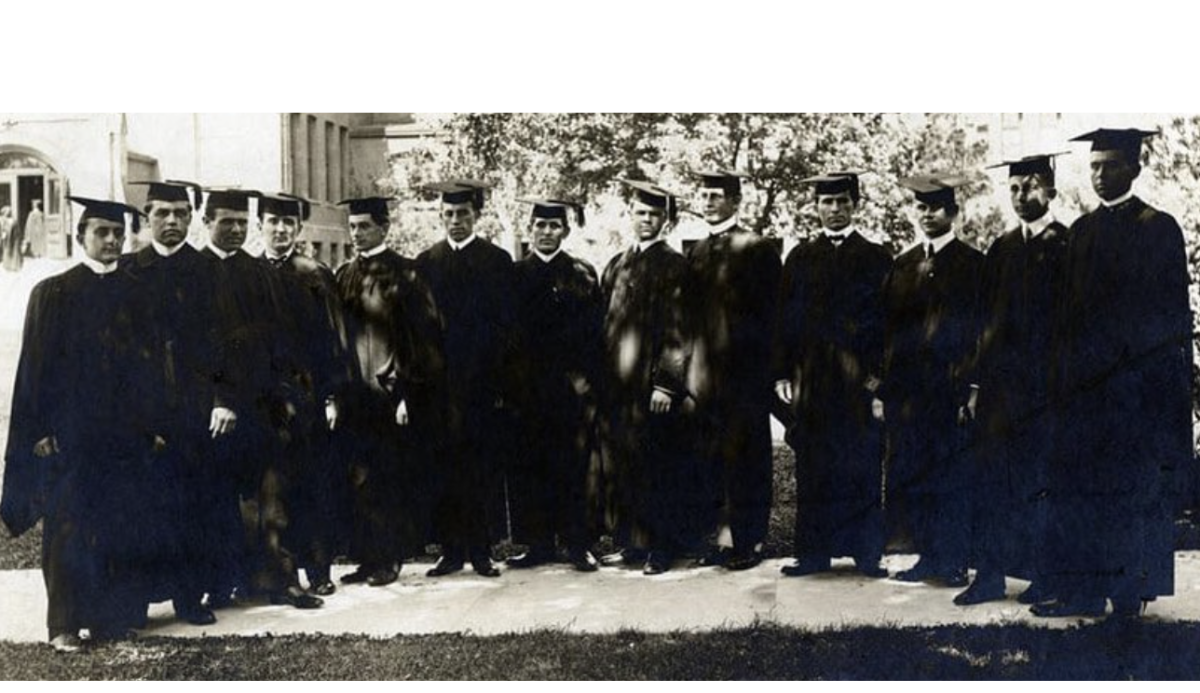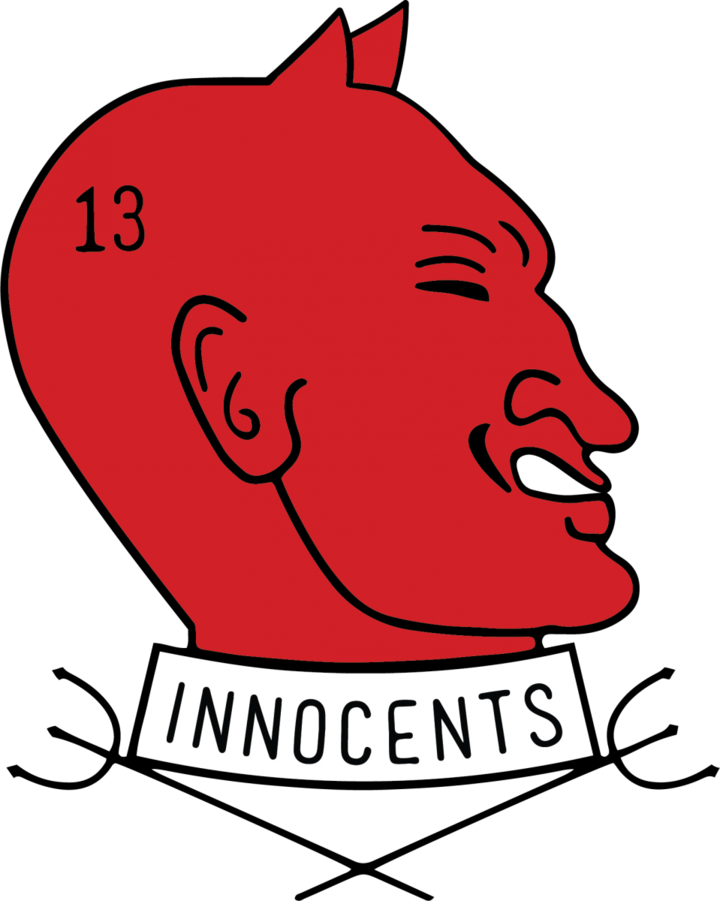"...the Society has been leading the campus in all aspects and promoting school spirit for more than 100 years."
The Innocents Society is the only Chancellor's Senior Honorary at the University of Nebraska-Lincoln and the oldest Nebraskan tradition. Currently in its 121st year, the Society has been an integral part of the campus community throughout the history of the University. Below are selected pieces of that history.

Founding
The Innocents Society was announced in The Daily Nebraskan on April 24th, 1903. Roscoe Pound, one of the guiding forces behind the establishment of the Innocents Society, was then dean at the University and went on to become the dean of the Harvard Law School. It was after the societies of Harvard and Yale that the Innocents Society was modeled. The tackling tradition, among other things, was established based on the traditions of these Ivy League groups. Pound characterized the purpose of the Innocents as this: “to advance University interests at every possible point; to furnish a compact corps of harmonious workers, where college spirit and enthusiasm might be generated; to give a body of men who would be pledged to put their shoulders to the wheel in all University undertakings; to be a guiding central body to lead in those things that fail in the University of Nebraska because, being left to the student body in general, the old maxim applies, ‘What is everybody’s business is nobody’s business.’”
Yell Squad
The Innocents, staying true to their goal of promoting school spirit, were heavily involved in athletic events and founded the yell squad in 1903. They selected its members from the men of the sophomore class and trained them as well. The Innocents led the football rallies before each game, planned Cornhusker banquets held at the end of each football season, ushered and checked IDs at football games, and helped the University to acquire an athletic field in the 1910s. In 1930, the Innocents were responsible for the football rooting section's national recognition as one of the best in the country. The Innocents oversaw halftime entertainment at football games, including stunts, and beginning in 1933, the color card section.
Trophy Exchanges
Missouri-Nebraska Bell Exchange
The bell dates back to 1892, when it was taken from a church in Seward by members of Phi Delta Theta and Delta Tau Delta. At the time, the members of the two fraternities occupied the same house. When the two groups moved into separate houses, there was a dispute over who should keep the bell. Annual scholastic or athletic contests were held, with the bell being used as a trophy. This rivalry abated, yet still the ownership of the bell was left in question. In 1926, the athletic director at Missouri, Chester D. Brewer, suggested an annual award be established for the annual Missouri-Nebraska football game. The bell was selected to be the prize to end the conflict between the fraternities, and an ‘M’ and an ‘N’ were engraved on opposite sides of the bell. The exchange was coordinated by the Innocents Society and Missouri’s prestigious Q.E.B.H. Society. Missouri won the first game 7-6 in 1927, and the scores from the games are engraved on the bell stand until 2010. This came to an end when Nebraska moved to the Big Ten conference, discontinuing one of the oldest traditions in college football.
Buffalo Head Exchange
In 1951, the Innocents Society organized a Buffalo Head Exchange with the University of Colorado’s Heart and Dagger Society. The Heart and Dagger Society bought the buffalo head and had it mounted for $20. The buffalo came to be known as Mr. Chip, receiving its name from an ill-fated mascot from Colorado. The winner of the annual Nebraska-Colorado football game took home Mr. Chip. The last exchange was made in the fall of 1962. Nebraska won the game, but Colorado could not produce Mr. Chip because he had been permanently misplaced during their possession of him.
The Corn Bowl
As the University moves forward into a new chapter in its history, so does the Society. The 107th class of Innocents created a new traditional trophy exchange with the President's Leadership Society at University of Iowa. The Corn Bowl was selected by popular vote of more than 4,000 citizens of both states and is the official trophy of the student bodies of both universities. Both Nebraska and Iowa have a base covered with plaques, which are engraved when each respective school wins the trophy. The Corn Bowl exchange also contains a service component in the form of a blood drive. The school that donates the most blood gets to fill the trophy with its state’s corn.
Campus Development
The Innocents Society also dedicated itself to activities which better the University and community. The University of Nebraska campus was quite small in the early 1900s, and the Innocents were responsible for coordinating several campus events. They conducted the Freshmen Convocation at the beginning of each year to welcome new students and initiate them into Cornhusker traditions. Beginning in 1909, the Innocents supervised an annual Olympics between the sophomores and freshmen. They sponsored the annual Junior-Senior prom, and attendance at the Innocents pre-party dinner was a highly regarded social honor. Around 1930, the Innocents created a Homecoming decoration contest for fraternities and sororities, and for many years judged and selected the winners.
The Innocents Society also administered one of the oldest traditions at the University, the distribution of freshmen caps. While the beanies were originally green, they were changed to red in 1932 and bore the year of the incoming class's graduation. Beanies were worn until Homecoming Day, at which time an annual tug-of-war took place between the freshmen and upperclassmen. If the freshmen won, which they traditionally did, they were allowed to discard their caps.
Innocents also helped to found a Student Council at UNL, the predecessor to today’s ASUN. New activities embraced by the Innocents included helping out with New Student week, sponsoring the annual Frosh Hop, and interviewing candidates for the title of Nebraska sweetheart. During the 1940s, the Innocents began to wear identical jackets one day each week. The jackets had the Innocents emblem over the pocket and served to increase the visibility of the organization. This tradition was carried on until the early 1960s. The Innocents also began to award Scholarship-Activities trophies each year to the three fraternities which displayed the greatest achievements in these areas. They supervised student elections and Homecoming Queen elections. They took part in a Speakers Bureau with Mortar Board which allowed them to provide a student perspective on the University to civic organizations across Nebraska. In 1963, they helped out with the first Masters Week. They continued to give the Homecoming display awards, sell freshmen beanies, select the all-male yell squad, and usher at football games.
World War II Efforts
The Innocents also helped immensely in both world war efforts. Early in the century, the Innocents would only appear in their robes once a year on Ivy Day to tackle new members. Thousands of people witnessed the ‘climax’ of Ivy Day, which occurred annually when the new Innocents were tackled. The student newspaper, referred to as 'the rag,' published 'racing forms' which predicted who the new Innocents and Mortar Board members would be before Ivy Day. In 1943, the new Innocents were tackled months early since it was believed that the draft would soon take these men away from the University. By the fall of 1943, all but one of these Innocents were overseas fighting in World War II. The remaining member single-handedly promoted the sale of freshmen caps and spoke at the freshman convocation in 1943. Tackling of new members was postponed until the semester following the end of the war. After the war, thirteen past Innocents re-established the Society, and new members were again tackled in 1947.
Revitalization
Like many students during the 1970s, the Innocents were rebellious. They were not action oriented and rarely met, except to select new members. One of the most significant events of the decade was in 1976 when women were admitted to the group to comply with Title IX. The size of the group varied, having anywhere from eight to fifteen members. Traditions would be restored, though, in the coming years.
In 1981, the members of the Innocents Society focused on what they termed as the revitalization of the organization. The members went 'underground' for two months because they felt the Innocents Society had lost its focus and traditions. They met off campus and didn’t appear publicly as a group until they were more sure of what the Innocents Society represented. They came out of this hiatus with a new vision and understanding of the Innocents Society. This class of Innocents revived many of traditions that had been lost during the 1970s and brought the group back up to its high standards.
Around 2005, the Innocents started a new tradition, one hoping to restore the selfless service aspect of the society's goals. They embraced a local charity directly connected with their class of Innocents and hoped each future class of Innocents would do the same. The tradition continues to this day. Whether through direct volunteering or raising funds to support a charity or cause, each subsequent class has continued to selflessly serve the community through this new tradition. The 104th class of Innocents expanded on the tradition of philanthropy by taking service statewide. In a three-day trip called IVAN (Innocents Volunteering Across Nebraska), the class stopped at 13 towns throughout Nebraska to undertake 13 different service projects. As the society progresses, its members continue to redefine service, leadership, and scholarship.
